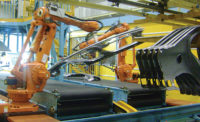Producing high-quality microelectronics requires efficient and accurate handling of components throughout the assembly process. Manufacturers like Infineon Technologies NA, based in Morgan Hill, CA, face this challenge on a daily basis.
Infineon produces millions of radio frequency power transistors every year for use in cell phone base stations. To ac-curately handle such a large amount of transistor components, the company has relied on the 1110 series of magazine handlers from Martek Automation for several years.
Magazine handlers provide three main advantages over manual material handling: less contamination, lower labor and operating costs, and higher quality products due to no human error.
Each machine handles multiple aluminum or stainless steel magazines (carriers) that have 10 internal slots and an exter-nal handle. Separate handlers are located at the front and rear of the assembly line or workcell.
Before production begins, each slot in the magazine on the front handler must be filled with a tray-like device called an Auer boat. An operator or robot loads each boat with all components needed for the assembly process.
With all boats filled and in place, production begins. The machine automatically moves a boat onto the front of a con-veyor that feeds a line or cell. At each workstation, a pick-and-place robot or other automated equipment assembles the components and places the completed assembly back into the boat and the boat onto the rear of the conveyor. The boat is conveyed onto the rear handler and guided into an empty magazine slot. After all slots are filled, the magazine is manually carried or automatically transported to the next line or cell for further assembly.
“Simplicity of design is important [when] choosing a magazine handler,” says Alexander Komposch, head of package and process development for Infineon. “Such design guarantees ease of operation and manufacturing robustness. In the past, designers we worked with tended to overdesign the handler to the point that it was unreliable and had to be removed from production after a short time.”
Komposch likes the handlers’ ability to handle eight magazines (up to 6 inches wide and 12 inches long) on the input and output sides. Previous machines Infineon used were only able to handle four magazines. The handlers are also able to stack magazines two rows high to improve throughput speed, and they quickly detect the exact location of an empty slot.
Alignment is critical when incorporating handlers into a production line. Martek’s handlers feature heavy welded steel frames that ensure alignment even when the handler is bumped into by an operator. The handlers are not anchored, but free standing.
Another reason Infineon chose these handlers is they require little maintenance. By eliminating handler downtime, the company optimizes the uptime of its primary systems, such as wire bonding equipment.
“The only part on the handler that requires replacement is the pinch roller, which is a simple silicon wheel,” notes Komposch. “In 24/7 production, you [can’t] have downtime. Handler reliability is essential to avoid that problem.”
For more information on magazine handlers, call 951-304-0541 or visit www.martekautomation.com.





